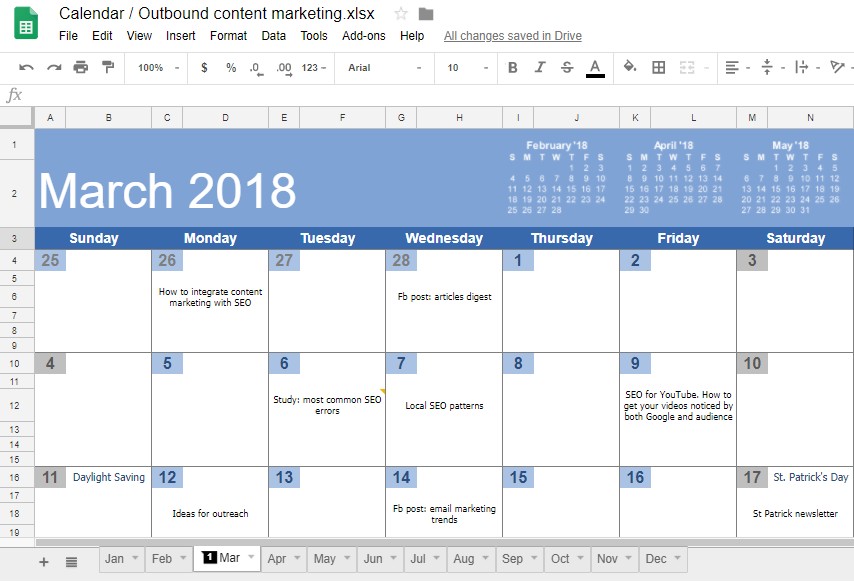The following is a guest post by Anna Rud. Anna is a Content Marketer at Serpstat. Establishing an active presence on external resources, developing rich and quality content, implementing brand strategy and many others are her key responsibilities.
The lack of content planning could be the death of many businesses. It seems like some site owners are making every effort to create a business strategy, organize their sales and lead generation. At the same time, they don’t seek to give any importance to content planning.
But publishing posts with no strategy and analysis behind it isn’t something that brings traffic and conversions, and we all have to deal with it.
It this post, I’m going to tell you how to organize your editorial calendar and give some tips on how to fill it up with traffic-driving content.
Before you read on - we have various resources that show you exactly how to use social networks to gain massive traffic and leads. For instance, check out the following:
FREE Step-by-Step Twitter Marketing GuideFREE Pinterest Marketing Ebook
Why would you want to start planning
The answer is pretty simple: it will make your life easier, less stressful, and blank pages panic free! Here is why I think so:
- You can spend a few days working hard on your content plan, and then you’ll be able to forget about this kind of work for a few months. Your content creation process won’t be messy and random so that you can focus on the most interesting part: writing! It is the same thing with the article writing process. Once you have created an outline for your article, the whole process goes faster as you know your future steps. You don’t have to start every single day looking at the blank page for hours. You have all ideas put together in one place, and you can start writing right away.
- You’re always prepared for predictable trends. Sure, we can’t predict everything (Google or Facebook updates, cryptocurrency collapse, new features of your competitors), but we can predict some things like holidays, your own product updates, Birthdays of opinion leaders in your niche, etc. An editorial calendar helps you keep in mind these issues. Well, hold on, that’s not entirely true. You don’t even have to “keep it in mind”, you have all these dates scheduled!
- You can target several goals at the same time. When you have all your plans organized in one place, it’s easy to take more tasks, launch more campaigns, and so on.
- You can keep track of your ideas as they come, and keep it all in one place. I used to write down ideas on napkins or notes on the phone, and I’m sure I’ve lost a lot of great thoughts this way.
- It’s easy to collaborate with your team. You can see the plans of your colleagues and brainstorm right in this document.
There are a lot of reasons to maintain an editorial calendar. Here I’ll stop talking about how much benefit it will bring to you and simply show you everything in action.
How to organize your editorial calendar
1. Find a calendar
I know my speech about benefits may seem like I’m trying to sell some project management tool. Well, no, that’s not the case. I personally use a free template I downloaded from this site:
I uploaded it to my Google drive so that I can share it with my colleagues. Pretty simple. There are no additional options and functions so it may be not enough for large companies. But if you work alone or with a small team, this calendar would be a great fit for you.
It automatically shows you dates of holidays, you have a lot of space to describe your idea, and you can use comments to add some notes.
2. Choose a time
If you’re running a blog, you should have a schedule for posting. It could be a few times per month, once a week, three times a week or even every day. It depends on what kind of content you’re posting. Choose these days and mark them out in the spreadsheet. Planning posts for the same days makes it easy for you to keep your schedule consistent and for the reader to find your new posts fast.
It’s quite difficult to advise what days are the best for publications as it works differently for every particular audience. Having said that, there are some great studies that can help you find an optimal time for you, such as this one by BuzzSumo. Their study shows that the most “shareable” days are Tuesday and Thursday.
Hey, before you read on - we have in various FREE in-depth guides on similar topics that you can download. For this post, check out:
FREE workbook: CREATE AWESOME BLOG POSTSFREE Beginner's Guide: START A BLOG
Of course, you shouldn’t believe these studies entirely, but they might help you anyway. Read some of them and then test, test, and test once more. After a while, you’ll be able to choose the perfect time for the publications, when your audience is most active.
3. Come up with the topics
Keyword research and clustering
Now we’re ready to fill our calendar up with ideas. No matter if it’s ideas for blog posts or social media platforms, the first step is always keyword research.
Put simply, keywords are the words and phrases that people enter into search engines frequently. It means that there are a lot of people eager to find this information. It can give you a great insight into what people would like to know inside your niche. These search queries can not only improve your site’s rankings but inspire you and give a bunch of ideas as well.
You can use any SEO tool you like the most to conduct your keyword research. I don’t think this issue requires a long explanation as every person that deals with content creation probably knows how to go about doing keyword research.
In a few words, open your favorite tool, type your primary keyword (women shoes, hiking, online marketing – the main thing about what you do) and download the spreadsheet with a bunch of keywords your tool put together for you.
The problem is that such tools give you a huge list of keywords, so it’s easy to mess things up. This huge list rather scares you than inspires.
I recommend using tools that contain a keyword clustering feature. One of them is Serpstat. This tool will break keywords into groups and help make sense of a long list of keywords.
Now I have a few well-structured groups of keywords, I know that these queries are interesting for my audience, and can come up with topics that most likely will drive traffic to my blog. In addition, Serpstat has a Text Analysis feature that suggests what keywords you may want to use in Title, Description and Body text.
Follow discussions
Another way to be sure that your content is interesting for your audience is to follow discussions on Quora, Reddit, and topical forums. Also, I suggest following niche thought leaders on Facebook, Instagram, and Twitter. Find experts in your niche, monitor their social media platforms, and you’ll be aware of everything that happens in your niche.
The discussions on question-and-answer platforms and forums also will give you a great insight into what is trending in your field at this very moment. Thus, you can come up with a thoughtful and effective strategy.
The last thing I’ll mention is competitor analysis. This is also a crucial step when organizing your content strategy. Analyzing their content you can:
- find weak and strong points in their strategy to avoid making their mistakes and steal some good ideas.
- find their best performing content to see what works well with their audience (as you probably have similar audiences and it might help you find a right direction).
- make sure you’re not going to do write the same (or similar) content.
Tools like BuzzSumo can help find the best articles of your competitors.
4. Add these topics to your editorial calendar
After the analysis of your competitors, finding keywords, and searching for recent discussions in your field, you’re ready to come up with your content strategy. Here are few things you should keep in mind:
- Note all upcoming occasions your content should focus on;
- Add to your calendar all holidays which somehow can be used in your content strategy;
- Take into consideration news and updates specific to your niche;
- Mix up different formats on your blog (interview, listing, how-to, roundup, digest). You can specify a day for each format;
- Choose the most trending topics (discussions on forums/social media platforms and Google Trends will come in handy);
- Сalculate the time that you can spend on each article.
Keep in mind all these factors when specifying the date for each topic you found.
You may want to create another spreadsheet with more detailed information. (especially if you work with a team of writers) Here is the example of such content plan:
It’s possible that something more important will appear or the article will take longer than you planned, so you can shift or push back some topics. Anyway, try to stick to the plan and your content creation process will be much more organized!
 Summing up
Summing up
Random articles with zero analysis behind it never bring a lot of traffic and conversions regularly. It could be a lucky coincidence, but luck won’t be with you forever. Your content strategy must be thought through, and only this way you’ll get noticeable results. So:
- Create a calendar;
- Choose the time for posting;
- Conduct keyword research;
- Follow discussions;
- Analyze competitors;
- Add topics to your editorial calendar;
- And get ready for traffic growth!
Do you want to create better blog posts? Do you want to learn about some types of blog posts you did not know? Do you need help to structure your posts in the best way?
Our Blog Post Templates help you with all that. Get 6 blog post templates for free. Download our blog post templates here!








